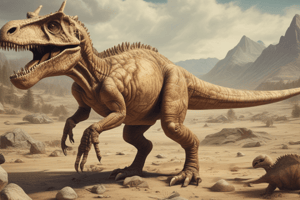Podcast
Questions and Answers
What is the definition of fossils?
What is the definition of fossils?
- The complete remains of animals and plants rotting in open air.
- Only the bones of ancient dinosaurs found in mountainous regions.
- Impressions left by organisms in freshly fallen snow.
- Preserved remains of organisms that lived in ancient times, typically buried under sediments. (correct)
Which environments are likely to contain fossilized remains?
Which environments are likely to contain fossilized remains?
- Ancient seas, lakes, and rivers. (correct)
- Modern urban settings.
- Volcanic craters and lava tubes.
- Open grasslands and deserts.
What age must a preserved trace of life be to be classified as a fossil?
What age must a preserved trace of life be to be classified as a fossil?
- At least 1,000 years old.
- More than 10,000 years old. (correct)
- No more than 10,000 years old.
- Exactly 100 years old.
Which of the following statements about fossils is true?
Which of the following statements about fossils is true?
What processes are primarily involved in the formation of fossils?
What processes are primarily involved in the formation of fossils?
Flashcards are hidden until you start studying
Study Notes
Fossils Overview
- Fossils represent the preserved remains of ancient plants and animals.
- Formation occurs when bodies are buried in sediments, primarily sand and mud.
- Ideal burial locations include ancient seas, lakes, and rivers.
Fossil Characteristics
- Fossils serve as crucial evidence of past life on Earth.
- They can provide insights into prehistoric ecosystems and species interactions.
- Typically, only remains that are over 10,000 years old qualify as fossils.
Preservation Conditions
- Sedimentary environments enhance the chances of fossil formation.
- Rapid burial in sediment protects remains from decay and scavengers.
- Mineralization often occurs, turning organic materials into rock-like structures.
Studying That Suits You
Use AI to generate personalized quizzes and flashcards to suit your learning preferences.




